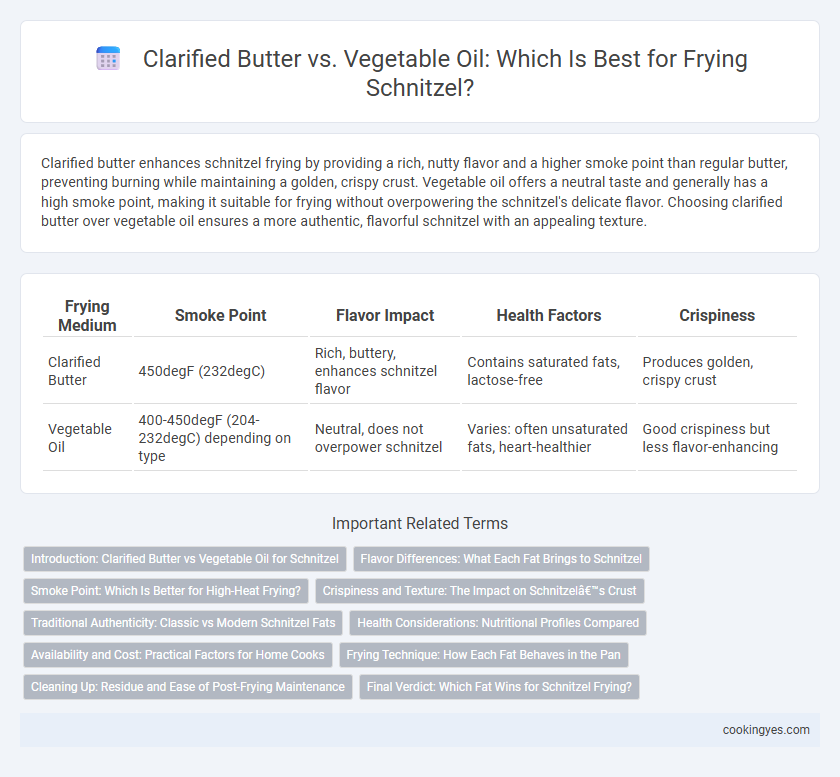Clarified butter enhances schnitzel frying by providing a rich, nutty flavor and a higher smoke point than regular butter, preventing burning while maintaining a golden, crispy crust. Vegetable oil offers a neutral taste and generally has a high smoke point, making it suitable for frying without overpowering the schnitzel's delicate flavor. Choosing clarified butter over vegetable oil ensures a more authentic, flavorful schnitzel with an appealing texture.
Table of Comparison
| Frying Medium | Smoke Point | Flavor Impact | Health Factors | Crispiness |
|---|---|---|---|---|
| Clarified Butter | 450degF (232degC) | Rich, buttery, enhances schnitzel flavor | Contains saturated fats, lactose-free | Produces golden, crispy crust |
| Vegetable Oil | 400-450degF (204-232degC) depending on type | Neutral, does not overpower schnitzel | Varies: often unsaturated fats, heart-healthier | Good crispiness but less flavor-enhancing |
Introduction: Clarified Butter vs Vegetable Oil for Schnitzel
Clarified butter offers a rich, nutty flavor ideal for traditional schnitzel, while its higher smoke point compared to regular butter ensures crisp frying without burning. Vegetable oil provides a neutral taste and is cost-effective, maintaining a consistent frying temperature for an evenly cooked schnitzel. Choosing between clarified butter and vegetable oil depends on balancing flavor depth with frying performance.
Flavor Differences: What Each Fat Brings to Schnitzel
Clarified butter imparts a rich, nutty flavor and deep, golden crispiness to schnitzel, enhancing its traditional taste profile. Vegetable oil offers a neutral palette, allowing the breading and meat flavors to stand out without adding significant taste. Choosing clarified butter intensifies the savory notes, while vegetable oil keeps the flavor lighter and more delicate.
Smoke Point: Which Is Better for High-Heat Frying?
Clarified butter has a higher smoke point of approximately 450degF (232degC) compared to most vegetable oils, which generally range between 350degF to 400degF (177degC to 204degC), making it more suitable for high-heat frying of schnitzel. The elevated smoke point of clarified butter reduces the risk of burning and imparts a rich, nutty flavor essential for achieving the classic schnitzel crust. Vegetable oils with lower smoke points may break down faster, producing off-flavors and harmful compounds during the high-heat frying process.
Crispiness and Texture: The Impact on Schnitzel’s Crust
Clarified butter enhances schnitzel's crust by providing a rich, nutty flavor and a golden, crispy texture due to its higher smoke point compared to regular butter. Vegetable oil, with its neutral taste and high smoke point, promotes an even, crunchy crust but lacks the depth of flavor that clarified butter imparts. Choosing clarified butter over vegetable oil intensifies crispiness while maintaining a tender, juicy interior, making it ideal for a classic, flavorful schnitzel.
Traditional Authenticity: Classic vs Modern Schnitzel Fats
Clarified butter, rich in milk solids and with a high smoke point, preserves the traditional flavor and texture of authentic schnitzel, imparting a nutty aroma that aligns with classic Central European culinary methods. Vegetable oil, commonly used in modern schnitzel preparation, offers a neutral taste and higher heat tolerance, enabling crispier crusts but sacrificing the depth of flavor characteristic of traditional recipes. The choice between clarified butter and vegetable oil reflects a balance between maintaining historical authenticity and adapting to contemporary frying techniques for schnitzel.
Health Considerations: Nutritional Profiles Compared
Clarified butter contains mostly pure fat with minimal milk solids, offering a rich flavor while providing fat-soluble vitamins A, D, E, and K but also being high in saturated fats. Vegetable oils, such as canola or sunflower, typically contain more unsaturated fats and essential fatty acids, which may support heart health by reducing LDL cholesterol levels. Choosing clarified butter or vegetable oil for frying schnitzel impacts nutritional intake, with vegetable oil generally favored for healthier lipid profiles despite the distinct taste and higher smoke point of clarified butter.
Availability and Cost: Practical Factors for Home Cooks
Clarified butter offers a rich flavor ideal for schnitzel but is often pricier and less readily available than vegetable oil, which is widely accessible and budget-friendly. Home cooks may find vegetable oils like canola or sunflower more economical and practical for frequent frying due to their longer shelf life and lower cost. Balancing flavor preferences with availability and cost can help choose the best frying medium for schnitzel preparation.
Frying Technique: How Each Fat Behaves in the Pan
Clarified butter offers a higher smoke point of around 450degF, allowing schnitzel to fry evenly with a rich, nutty flavor while creating a crisp, golden crust. Vegetable oil, typically refined sunflower or canola oil with smoke points near 400degF, provides a neutral taste and consistent heat distribution but lacks the depth of flavor that clarified butter imparts. The clarified butter's milk solids removal prevents burning, making it superior for maintaining pan temperature and achieving perfect schnitzel texture compared to vegetable oil's tendency to break down faster at high heat.
Cleaning Up: Residue and Ease of Post-Frying Maintenance
Clarified butter leaves a rich, golden residue on pans that can require more effort to clean due to its milk solids, but it enhances schnitzel flavor with a natural, buttery taste. Vegetable oil residues tend to be lighter and less sticky, making post-frying maintenance quicker and simpler. Choosing vegetable oil reduces the risk of burnt residues, streamlining cleanup and extending cookware life after frying schnitzel.
Final Verdict: Which Fat Wins for Schnitzel Frying?
Clarified butter offers a rich, nutty flavor and a higher smoke point than regular butter, making it ideal for achieving a crispy, golden schnitzel without burning. Vegetable oil provides a neutral taste and even heating but lacks the depth of flavor and the crispy texture that clarified butter imparts. For the perfect schnitzel frying experience, clarified butter wins by delivering superior flavor and optimal browning while withstanding high frying temperatures.
Clarified butter vs vegetable oil for schnitzel frying Infographic

 cookingyes.com
cookingyes.com